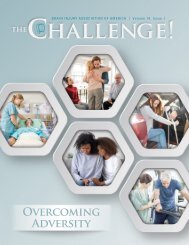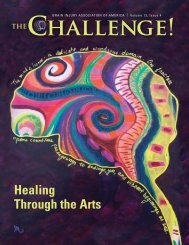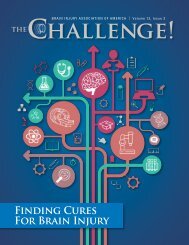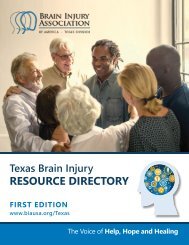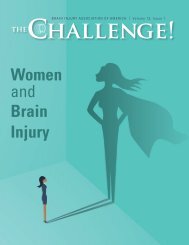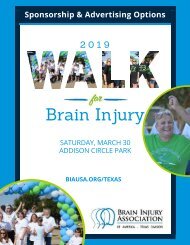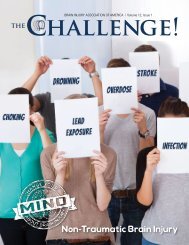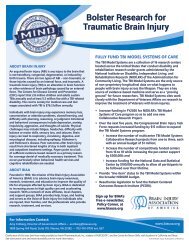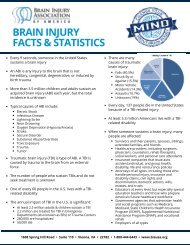THE Challenge! Spring 2011
Communication
Communication
Create successful ePaper yourself
Turn your PDF publications into a flip-book with our unique Google optimized e-Paper software.
Brain Injury<br />
Awareness Day<br />
Brain Injury<br />
Awareness Day<br />
By Laurie Kusek, Director of Communications, Brain Injury Association of America<br />
Brain Injury Awareness Day on<br />
Capitol Hill was held on March 16,<br />
<strong>2011</strong>. As in years past, advocates<br />
and Congressional staff attended an<br />
awareness fair, briefing and reception. This<br />
year’s briefing focused on Brain Injury<br />
Rehabilitation and Re-Entry: Lessons<br />
Learned and the Road Ahead, with speakers<br />
emphasizing the importance of rehabilitation<br />
in maximizing recovery for people with brain<br />
injury.<br />
“One of the first commitments I made after<br />
becoming a congressman 14 years ago was to make the U.S.<br />
Congress, and the public, aware of the dangers of traumatic<br />
brain injury (TBI). As part of that commitment and in my role<br />
as co-chairman of the Congressional Brain Injury Task Force,<br />
every year I host a day on Capitol Hill dedicated to brain injury<br />
awareness,” said Rep. Bill Pascrell (D-NJ), who co-chairs the<br />
task force with Rep. Todd Platts (R-PA). “I speak as an advocate<br />
for brain injury patients, and what we need now is support –<br />
support for better policies for our service members, support for<br />
federal guidelines to protect our student athletes, and support<br />
for healthcare reform so that no matter your insurance, you will<br />
have access to care.”<br />
Seven panelists were invited to speak about the research,<br />
education and importance of rehabilitation they’ve been<br />
involved with at their institutions and with their families.<br />
Speakers included Brig. Gen. Richard W. Thomas, Army<br />
assistant surgeon general, force protection; Col. Jamie B.<br />
Grimes, director, Defense and Veterans Brain Injury Center;<br />
Kathy Helmick, deputy director, Defense Centers of Excellence<br />
for Psychological Health and Traumatic Brain Injury; Patty<br />
Horan, wife of a wounded warrior, Army Capt. Patrick Horan;<br />
<strong>2011</strong><br />
Dr. Lisa McGuire, research team leader,<br />
Division of Injury Response, Centers for<br />
Disease Control and Prevention; Dr. Keith<br />
Cicerone, director of Neuropsychology<br />
and Rehabilitation Psychology at the JFK-<br />
Johnson Rehabilitation Institute and New<br />
Jersey Neuroscience Institute, JFK Medical<br />
Center (one of 16 TBI Model Systems<br />
research centers under the Department<br />
of Education); and Dr. Anne Forrest,<br />
traumatic brain injury advocate, formerly<br />
senior economist at the Environmental<br />
Law Institute.<br />
As reported by the Army News Service, Patty Horan, wife of<br />
Capt. Patrick Horan, shared that Patrick suffered a gunshot<br />
wound to the left side of his head while serving in Iraq in 2007.<br />
The injury left him completely disabled. It destroyed his ability<br />
to walk, he lost all coordination and sensation on the right side<br />
of his body and he lost the ability to read, to write, to speak, to<br />
understand language, and it also destroyed his right visual field.<br />
“In the early stages of rehab, I was completely overwhelmed.<br />
His injury was so debilitating, I could not even imagine how he<br />
could possibly recover,” Patty said. “I thought our life would be<br />
lived in institutions, isolation, and unrealized dreams.”<br />
Capt. Horan began rehabilitation five weeks after the initial<br />
injury and about three months later the doctors told Patty that<br />
Pat would never be able to communicate effectively again. “My<br />
sister-in-law found a blog which talked about (a facility). Our<br />
neurosurgeon supported our decision, so we moved,” Patty said.<br />
At the center, Pat was given five hours of therapy a day,<br />
consisting of occupational, physical, speech, recreational and<br />
cognitive therapy, as well as community re-entry. “Because of<br />
(Continued on pg. 21)<br />
Patty Horan Audience, Brain Injury Awareness Day <strong>2011</strong> Anne Forrest<br />
<strong>THE</strong> <strong>Challenge</strong>! | <strong>Spring</strong> <strong>2011</strong><br />
14




